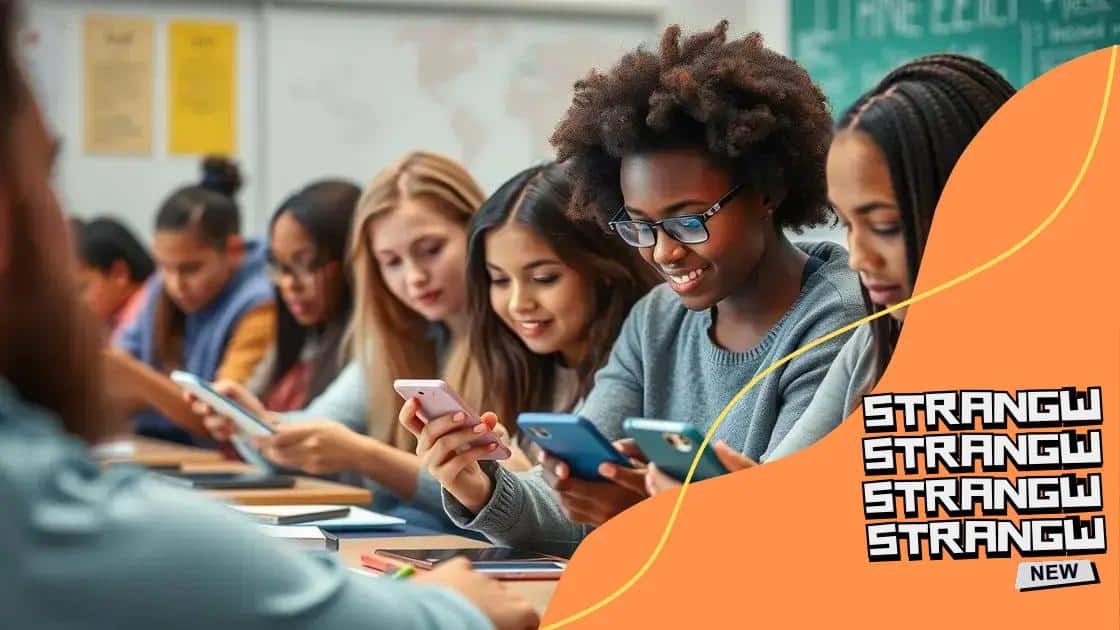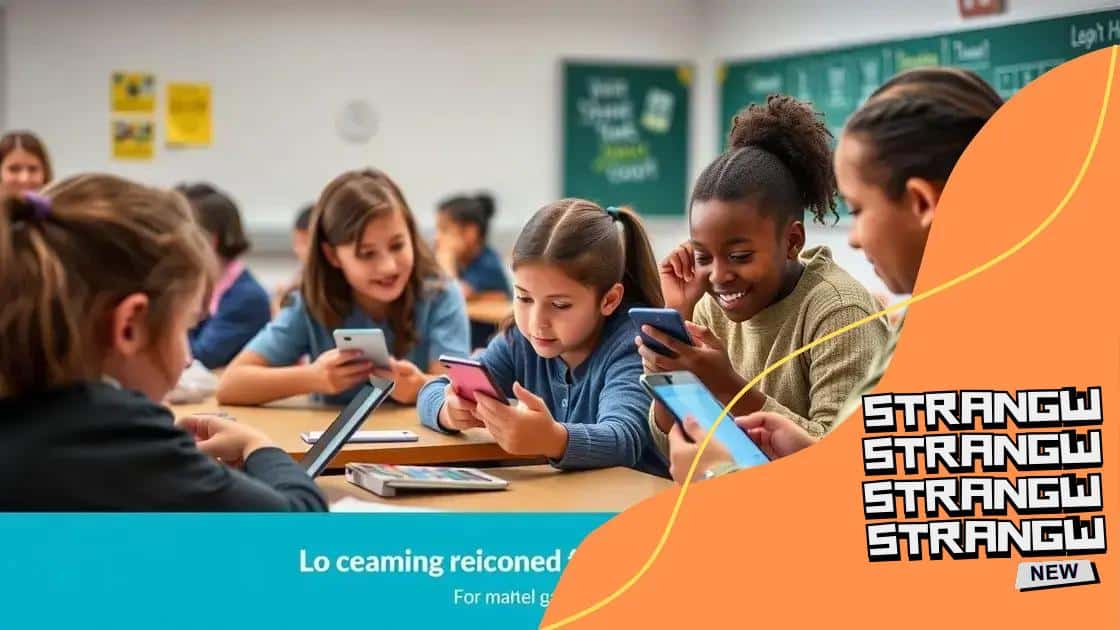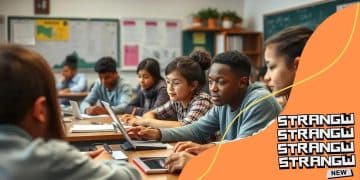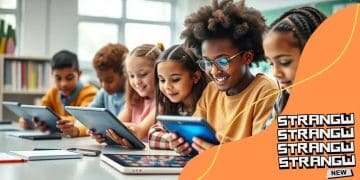Mobile learning applications transforming education today

Mobile learning applications leverage technologies like AI and AR to provide personalized, interactive, and accessible education experiences, enhancing student engagement and outcomes in various learning environments.
Mobile learning applications have become game-changers in education, offering students the flexibility to learn at their own pace. Have you ever wondered how these apps impact your learning experience? Let’s dive into this topic.
Benefits of mobile learning applications
Mobile learning applications are changing education for the better. They bring learning right to our fingertips, allowing flexibility and convenience for students of all ages. But what exactly are the benefits of these innovative tools?
Accessibility and Flexibility
One major advantage is that learning becomes accessible anytime and anywhere. Students no longer need to be tied to a specific location or time. Whether waiting for a bus or relaxing at home, learners can engage with their studies.
- Study on your own schedule
- Access course materials anywhere
- Incorporate learning into daily routines
Personalized Learning Experience
Another key benefit is how these applications allow for personalized learning. Each student can progress at their own pace, focusing on their unique strengths and weaknesses. This tailored approach can boost understanding and retention.
For instance, by using mobile apps, students can create custom study plans that fit their individual needs. Additionally, interactive features can make learning more engaging, which helps students stay motivated.
Cost-Effectiveness
Mobile learning applications can also be more affordable compared to traditional methods. Many mobile apps offer free resources or low-cost subscriptions, making education more accessible to everyone.
- Lower costs for educational materials
- Reduced travel expenses
- Online courses usually cheaper than in-person classes
Ultimately, mobile learning applications provide numerous benefits that make education more engaging and effective. From any location to personalized experiences and cost savings, they are shaping the future of learning.
Challenges in mobile learning
Mobile learning offers many advantages, but it also comes with its own set of challenges. Understanding these challenges is crucial for educators and learners alike.
Technical Issues
One significant challenge is the prevalence of technical issues. Not all students have access to reliable smartphones or high-speed internet. This disparity can create obstacles in the learning process.
- Slow internet can hinder resource access
- Device compatibility may limit app usage
- Technical support may not be readily available
Content Quality
Another important aspect is the quality of available content. While there are many helpful mobile learning applications, not all offer accurate or engaging material. Students might encounter low-quality resources, making it difficult to learn effectively.
This inconsistency can lead to frustration and a lack of motivation among learners. Educators must carefully evaluate the content of mobile learning applications to ensure it meets educational standards.
Distractions and Multitasking
Mobile devices can be a double-edged sword. They provide access to learning, but they also come with many distractions. Students can easily become sidetracked by social media notifications or games.
To combat this, it’s essential to create a focused learning environment. Students must learn how to manage their time and attention effectively while using these mobile applications.
Learning Styles
Lastly, not every student responds well to mobile learning. Some learners thrive in traditional classroom settings where interaction is more direct. Adapting to different learning styles is vital in making mobile education effective for everyone.
By recognizing these challenges, educators and learners can work together to find solutions. This awareness can lead to a more successful and enjoyable mobile learning experience.
Best practices for using mobile apps in education

Using mobile apps in education can greatly enhance the learning experience. However, implementing them effectively requires some best practices. Following these best practices can help both educators and students maximize their benefits.
Choose Quality Applications
First and foremost, it’s essential to select high-quality mobile applications. Not all apps are created equal, and educators should look for those that offer interactive and engaging content.
- Read reviews and ratings from other users.
- Evaluate the app’s educational value.
- Ensure it aligns with curriculum goals.
Encourage Active Learning
Another key practice is to encourage active learning. Passive consumption of information isn’t enough; students should engage actively with the content. This can be achieved through quizzes, discussions, and collaborative projects within the app.
Active learning helps students retain information better and develop critical thinking skills. Using features such as discussions and forums can facilitate meaningful interactions among learners.
Provide Clear Instructions
Clear instructions are vital when integrating mobile applications into the classroom. Students should know how to navigate the app and understand its features. Educators should provide tutorials or guides to help students become familiar with the technology.
This clarity builds confidence in learners, allowing them to focus on the content rather than figuring out how to use the app.
Monitor Progress
Monitoring student progress is also crucial. Many mobile applications provide analytics that can help educators track how well students are doing. This data can inform further instruction and support.
Regular check-ins can foster motivation, as students see their growth over time. Feedback based on their performance encourages them to improve and stay engaged.
Foster a Supportive Environment
Lastly, creating a supportive environment is key. Students should feel comfortable asking questions and sharing their experiences with the app. Teachers can facilitate this by establishing open lines of communication.
A supportive atmosphere allows students to express challenges they might encounter while using mobile learning applications.
Case studies of successful mobile learning
Examining case studies of successful mobile learning offers valuable insights into best practices and effective strategies. Various educational institutions and organizations have adopted mobile applications, leading to transformative results.
Harvard University: Engaging Students
One prominent example is Harvard University, where mobile learning apps were introduced to enhance student engagement. The university developed an app that provides easy access to course materials, schedules, and library resources. Students found that having information at their fingertips improved their study habits and overall satisfaction.
- Increased participation in class discussions.
- Higher rates of assignment submission and completion.
- Positive feedback on user experience and accessibility.
Duolingo: Language Learning
Duolingo is another success story in mobile learning. This app has revolutionized the way users learn new languages through gamification. The app employs elements like rewards and challenges to keep learners motivated. Duolingo reports a significant increase in user engagement due to its interactive approach.
The platform encourages daily practice, which helps users build consistent learning habits. Its success lies in making language learning fun and rewarding.
PwC: Employee Training
Professional development also benefits from mobile learning, as seen in the case of PwC. This global consulting firm developed a mobile app to provide on-the-go training for employees. It includes resources like videos, simulations, and quizzes.
Employees found that mobile training allowed them to learn in short bursts, fitting education into their busy schedules. The convenience and flexibility of mobile learning led to higher training completion rates and improved performance in the workplace.
Schools Using Mobile Solutions
Numerous schools have adopted mobile learning solutions to cater to various learning styles. For example, a school in California implemented a program where students used tablets loaded with educational apps to supplement traditional teaching methods.
This approach led to improved test scores and greater student interest in subjects like math and science. The interactive nature of mobile apps helped to enhance understanding and retention of the material.
These case studies highlight how different sectors successfully utilize mobile learning to foster engagement, improve outcomes, and create more effective educational environments. As technology continues to advance, mobile learning will likely play an increasingly important role in education and professional development.
Future trends in mobile learning technology
The future of mobile learning technology is bright and full of potential. As technology continues to evolve, we can expect several exciting trends to shape the landscape of education.
Integration of Artificial Intelligence
One major trend is the integration of artificial intelligence (AI) into mobile learning applications. AI can provide personalized learning experiences by adapting content to meet individual needs. This means students will receive tailored recommendations based on their learning pace and style.
- AI tutors can offer immediate feedback.
- Content can adjust based on student performance.
- Learning paths can be customized for each student.
Increased Use of Augmented Reality
Augmented reality (AR) is another technology that will revolutionize mobile learning. AR can create immersive learning environments by overlaying digital information on the real world. Imagine students using their smartphones to explore historical sites or conduct virtual science experiments with AR tools.
This technology enhances engagement and provides unique opportunities for interactive learning experiences, making complex subjects easier to understand.
Focus on Collaborative Learning
The future of mobile learning will also place a strong emphasis on collaboration. As apps improve, students will be able to work together on projects in real-time, sharing ideas and resources. This collaboration can take place across different locations, fostering a global learning community.
Features like chat rooms, shared documents, and group tasks will help students connect and collaborate effectively.
Gamification for Enhanced Engagement
Gamification will continue to play a vital role in mobile learning. By incorporating game-like elements, educational apps can motivate students to engage with the material actively. Elements such as points, badges, and leaderboards can create a fun and competitive atmosphere.
By turning learning into a game, students are more likely to stay focused and enjoy the learning process. This approach encourages persistence and a love for knowledge.
Greater Accessibility and Inclusivity
Finally, future trends will focus on making mobile learning more accessible to everyone. Developers are expected to create apps that cater to diverse learning needs, including those with disabilities. This includes features like voice commands and text-to-speech options.
Such advancements will ensure that mobile learning is inclusive, enabling all students to benefit from these educational resources.
FAQ – Frequently Asked Questions about Mobile Learning Technology
What are the main benefits of mobile learning applications?
Mobile learning applications offer flexibility, personalized learning experiences, and interactive content that engage students more effectively.
How can artificial intelligence enhance mobile learning?
AI can tailor educational content to individual learning styles, providing personalized recommendations and immediate feedback to students.
What role does augmented reality play in mobile education?
Augmented reality creates immersive learning experiences, allowing students to interact with digital content overlaid in the real world, making learning more engaging.
How can schools ensure accessibility in mobile learning?
Schools can implement features like voice commands, text-to-speech, and ensure their mobile apps are user-friendly for all students, including those with disabilities.





